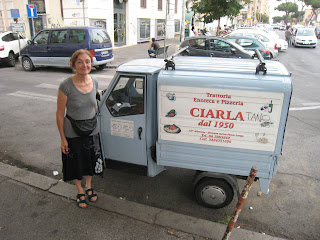 In Italy "small" has long been in fashion. In the towns and countryside, tiny, 3-wheeled vehicles, often flatbeds, many of them running on noisy and polluting but powerful 2-cycle engines (mixing gas with oil) that are prohibited in the cities, carry wood, produce, building supplies, and sundries. They're slow--they don't do more than about 30 mph--but they're inexpensive to operate, easy to fix, and for the farmers and tradesmen that use them, they're big enough to get the job done.
In Italy "small" has long been in fashion. In the towns and countryside, tiny, 3-wheeled vehicles, often flatbeds, many of them running on noisy and polluting but powerful 2-cycle engines (mixing gas with oil) that are prohibited in the cities, carry wood, produce, building supplies, and sundries. They're slow--they don't do more than about 30 mph--but they're inexpensive to operate, easy to fix, and for the farmers and tradesmen that use them, they're big enough to get the job done.  |
| Easy to park--here, in space reserved for scooters, in front of the Italian House of Deputies (Montecitorio). |
 |
| A three-wheeler. Careful on the turns! |
Many of these smaller trucks have only 3 wheels--sometimes 1 in front and 2 in back (unstable on turns) and, less often, 2 in front and 1 in back (better on turns, but more unstable generally).
 |
| 4-wheel Postal vehicle |
The Ufficio Postale, the Italian postal service, is a big user of these vehicles for its pick-up and delivery services. The one at left is a 4-wheeled model with small rear wheels and what appears to be a detachable door.
 |
| This one belongs to a restaurant. Dianne's there for proportion. |
Others are owned by private businesses, from restaurants to flea-market vendors.
(Ciarla, where we had dinner one evening, is on Via Appia Nuova).
We thought about buying one to help us with the task of distributing copies of Rome the Second Time.
 |
| Unidentified trucks attract graffiti. But then, so does everything. |
Unmarked mini-trucks appear to be a prime target of beginning graffiti writers, practicing their "tags."
Bill
 |
| A small flat-bed, used for hauling goods to a flea market. |







